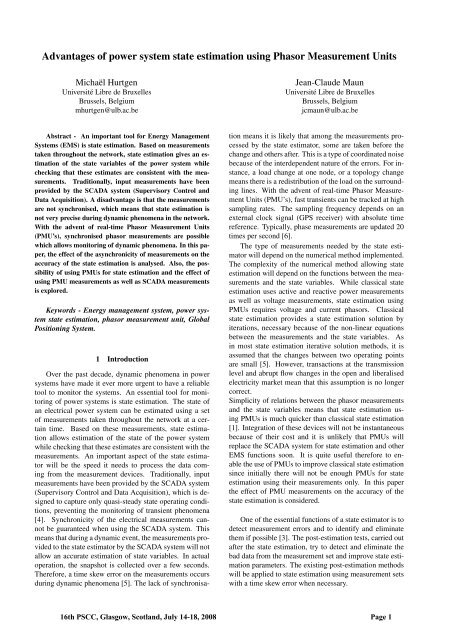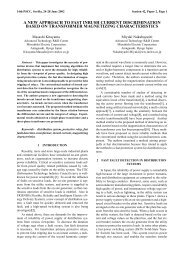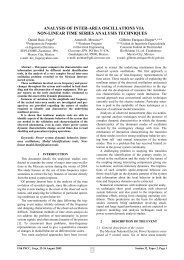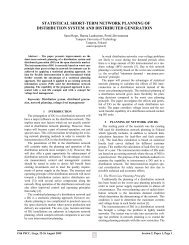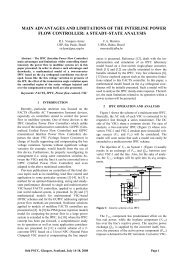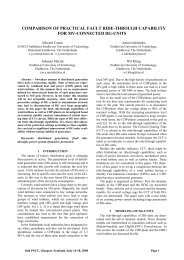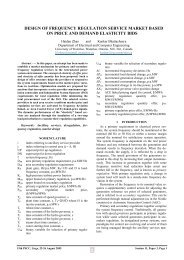Advantages of power system state estimation using Phasor ... - PSCC
Advantages of power system state estimation using Phasor ... - PSCC
Advantages of power system state estimation using Phasor ... - PSCC
You also want an ePaper? Increase the reach of your titles
YUMPU automatically turns print PDFs into web optimized ePapers that Google loves.
<strong>Advantages</strong> <strong>of</strong> <strong>power</strong> <strong>system</strong> <strong>state</strong> <strong>estimation</strong> <strong>using</strong> <strong>Phasor</strong> Measurement Units<br />
Michaël Hurtgen<br />
Université Libre de Bruxelles<br />
Brussels, Belgium<br />
mhurtgen@ulb.ac.be<br />
Jean-Claude Maun<br />
Université Libre de Bruxelles<br />
Brussels, Belgium<br />
jcmaun@ulb.ac.be<br />
Abstract - An important tool for Energy Management<br />
Systems (EMS) is <strong>state</strong> <strong>estimation</strong>. Based on measurements<br />
taken throughout the network, <strong>state</strong> <strong>estimation</strong> gives an <strong>estimation</strong><br />
<strong>of</strong> the <strong>state</strong> variables <strong>of</strong> the <strong>power</strong> <strong>system</strong> while<br />
checking that these estimates are consistent with the measurements.<br />
Traditionally, input measurements have been<br />
provided by the SCADA <strong>system</strong> (Supervisory Control and<br />
Data Acquisition). A disadvantage is that the measurements<br />
are not synchronised, which means that <strong>state</strong> <strong>estimation</strong> is<br />
not very precise during dynamic phenomena in the network.<br />
With the advent <strong>of</strong> real-time <strong>Phasor</strong> Measurement Units<br />
(PMU’s), synchronised phasor measurements are possible<br />
which allows monitoring <strong>of</strong> dynamic phenomena. In this paper,<br />
the effect <strong>of</strong> the asynchronicity <strong>of</strong> measurements on the<br />
accuracy <strong>of</strong> the <strong>state</strong> <strong>estimation</strong> is analysed. Also, the possibility<br />
<strong>of</strong> <strong>using</strong> PMUs for <strong>state</strong> <strong>estimation</strong> and the effect <strong>of</strong><br />
<strong>using</strong> PMU measurements as well as SCADA measurements<br />
is explored.<br />
Keywords - Energy management <strong>system</strong>, <strong>power</strong> <strong>system</strong><br />
<strong>state</strong> <strong>estimation</strong>, phasor measurement unit, Global<br />
Positioning System.<br />
1 Introduction<br />
Over the past decade, dynamic phenomena in <strong>power</strong><br />
<strong>system</strong>s have made it ever more urgent to have a reliable<br />
tool to monitor the <strong>system</strong>s. An essential tool for monitoring<br />
<strong>of</strong> <strong>power</strong> <strong>system</strong>s is <strong>state</strong> <strong>estimation</strong>. The <strong>state</strong> <strong>of</strong><br />
an electrical <strong>power</strong> <strong>system</strong> can be estimated <strong>using</strong> a set<br />
<strong>of</strong> measurements taken throughout the network at a certain<br />
time. Based on these measurements, <strong>state</strong> <strong>estimation</strong><br />
allows <strong>estimation</strong> <strong>of</strong> the <strong>state</strong> <strong>of</strong> the <strong>power</strong> <strong>system</strong><br />
while checking that these estimates are consistent with the<br />
measurements. An important aspect <strong>of</strong> the <strong>state</strong> estimator<br />
will be the speed it needs to process the data coming<br />
from the measurement devices. Traditionally, input<br />
measurements have been provided by the SCADA <strong>system</strong><br />
(Supervisory Control and Data Acquisition), which is designed<br />
to capture only quasi-steady <strong>state</strong> operating conditions,<br />
preventing the monitoring <strong>of</strong> transient phenomena<br />
[4]. Synchronicity <strong>of</strong> the electrical measurements cannot<br />
be guaranteed when <strong>using</strong> the SCADA <strong>system</strong>. This<br />
means that during a dynamic event, the measurements provided<br />
to the <strong>state</strong> estimator by the SCADA <strong>system</strong> will not<br />
allow an accurate <strong>estimation</strong> <strong>of</strong> <strong>state</strong> variables. In actual<br />
operation, the snapshot is collected over a few seconds.<br />
Therefore, a time skew error on the measurements occurs<br />
during dynamic phenomena [5]. The lack <strong>of</strong> synchronisation<br />
means it is likely that among the measurements processed<br />
by the <strong>state</strong> estimator, some are taken before the<br />
change and others after. This is a type <strong>of</strong> coordinated noise<br />
because <strong>of</strong> the interdependent nature <strong>of</strong> the errors. For instance,<br />
a load change at one node, or a topology change<br />
means there is a redistribution <strong>of</strong> the load on the surrounding<br />
lines. With the advent <strong>of</strong> real-time <strong>Phasor</strong> Measurement<br />
Units (PMU’s), fast transients can be tracked at high<br />
sampling rates. The sampling frequency depends on an<br />
external clock signal (GPS receiver) with absolute time<br />
reference. Typically, phase measurements are updated 20<br />
times per second [6].<br />
The type <strong>of</strong> measurements needed by the <strong>state</strong> estimator<br />
will depend on the numerical method implemented.<br />
The complexity <strong>of</strong> the numerical method allowing <strong>state</strong><br />
<strong>estimation</strong> will depend on the functions between the measurements<br />
and the <strong>state</strong> variables. While classical <strong>state</strong><br />
<strong>estimation</strong> uses active and reactive <strong>power</strong> measurements<br />
as well as voltage measurements, <strong>state</strong> <strong>estimation</strong> <strong>using</strong><br />
PMUs requires voltage and current phasors. Classical<br />
<strong>state</strong> <strong>estimation</strong> provides a <strong>state</strong> <strong>estimation</strong> solution by<br />
iterations, necessary because <strong>of</strong> the non-linear equations<br />
between the measurements and the <strong>state</strong> variables. As<br />
in most <strong>state</strong> <strong>estimation</strong> iterative solution methods, it is<br />
assumed that the changes between two operating points<br />
are small [5]. However, transactions at the transmission<br />
level and abrupt flow changes in the open and liberalised<br />
electricity market mean that this assumption is no longer<br />
correct.<br />
Simplicity <strong>of</strong> relations between the phasor measurements<br />
and the <strong>state</strong> variables means that <strong>state</strong> <strong>estimation</strong> <strong>using</strong><br />
PMUs is much quicker than classical <strong>state</strong> <strong>estimation</strong><br />
[1]. Integration <strong>of</strong> these devices will not be instantaneous<br />
because <strong>of</strong> their cost and it is unlikely that PMUs will<br />
replace the SCADA <strong>system</strong> for <strong>state</strong> <strong>estimation</strong> and other<br />
EMS functions soon. It is quite useful therefore to enable<br />
the use <strong>of</strong> PMUs to improve classical <strong>state</strong> <strong>estimation</strong><br />
since initially there will not be enough PMUs for <strong>state</strong><br />
<strong>estimation</strong> <strong>using</strong> their measurements only. In this paper<br />
the effect <strong>of</strong> PMU measurements on the accuracy <strong>of</strong> the<br />
<strong>state</strong> <strong>estimation</strong> is considered.<br />
One <strong>of</strong> the essential functions <strong>of</strong> a <strong>state</strong> estimator is to<br />
detect measurement errors and to identify and eliminate<br />
them if possible [3]. The post-<strong>estimation</strong> tests, carried out<br />
after the <strong>state</strong> <strong>estimation</strong>, try to detect and eliminate the<br />
bad data from the measurement set and improve <strong>state</strong> <strong>estimation</strong><br />
parameters. The existing post-<strong>estimation</strong> methods<br />
will be applied to <strong>state</strong> <strong>estimation</strong> <strong>using</strong> measurement sets<br />
with a time skew error when necessary.<br />
16th <strong>PSCC</strong>, Glasgow, Scotland, July 14-18, 2008 Page 1
In this paper, the effect <strong>of</strong> asynchronicity in the measurement<br />
set and <strong>of</strong> additional PMU measurements on the<br />
accuracy <strong>of</strong> the <strong>state</strong> <strong>estimation</strong> is analysed. The first section<br />
describes the measurements used by a <strong>state</strong> estimator.<br />
Subsequently the various <strong>state</strong> estimators are described.<br />
The third section describes the bad data identification<br />
and detection methods. Finally, simulations analysing the<br />
effect <strong>of</strong> time skew errors when <strong>using</strong> a weighted least<br />
squares <strong>state</strong> estimator are discussed.<br />
2 Measurements<br />
The output <strong>of</strong> a <strong>state</strong> estimator is the value <strong>of</strong> the <strong>state</strong><br />
variables at a given time, deduced from a set <strong>of</strong> measurements<br />
taken on the network. If z is the measurement vector<br />
then the model used by <strong>power</strong> <strong>system</strong> <strong>state</strong> <strong>estimation</strong><br />
is [7]:<br />
z = h(x) + e, (1)<br />
where x is the current <strong>state</strong> vector, h is the vector <strong>of</strong><br />
nonlinear measurement functions between x and z and<br />
e is the measurement noise vector. Currently, measurements<br />
are provided by the SCADA <strong>system</strong>. The SCADA<br />
<strong>system</strong> includes three components: the Remote Terminal<br />
Units (RTU), the communication links between RTUs<br />
and master stations or SCADA front end computers. The<br />
main function <strong>of</strong> SCADA is receiving and processing teleinformation,<br />
forming the real-time bases and archives, displaying<br />
the information, documenting the data and finally<br />
solving the dispatching tasks. The RTUs collect various<br />
types <strong>of</strong> measurements from the field and are responsible<br />
for transmitting them to the control center [3]. In this<br />
case the measurements are analog and represent voltage<br />
amplitudes, injected <strong>power</strong> at a node or line <strong>power</strong> flows.<br />
With the advent <strong>of</strong> real-time <strong>Phasor</strong> Measurement Units<br />
(PMU’s), fast transients can be tracked at high sampling<br />
rates. PMUs are actually numeric devices allowing synchronised<br />
phasor measurements. A GPS clock provides a<br />
phase and frequency-locked sample pulse, which permits<br />
synchronisation <strong>of</strong> sampled data taken at any point in the<br />
network. A phasor is a complex number associated with a<br />
sinusoidal wave and the phasors measured by PMUs will<br />
represent voltage at buses and current phasors in lines.<br />
During a dynamic event on the network such as a load or<br />
topology change, time skew errors can occur on measurements<br />
provided by the SCADA <strong>system</strong>. This is because<br />
the snapshot <strong>of</strong> measurements is collected over a few seconds<br />
by the SCADA <strong>system</strong>.<br />
In this paper, the time skew error is simulated as an<br />
asynchronicity rate p between the measurements taken before<br />
and after an event on the network. The asynchronicity<br />
rate p <strong>of</strong> the measurement set defines the number <strong>of</strong> measurements<br />
taken before and after the measurement set and<br />
determines the number <strong>of</strong> measurements taken from each<br />
set as shown in equations 2 and 3.<br />
m 1 = p m tot (2)<br />
m 2 = (1 − p) m tot (3)<br />
where m 1 is the number <strong>of</strong> measurements taken before the<br />
dynamic event, m 2 is the number <strong>of</strong> measurements taken<br />
after the change and m tot is the total number <strong>of</strong> measurements<br />
(m tot = m 1 + m 2 ). Because the measurements<br />
are taken over a period <strong>of</strong> a few seconds, the rate <strong>of</strong> asynchronicity<br />
<strong>of</strong> the measurement set will depend on the time<br />
when the dynamic event takes place. To get an idea <strong>of</strong><br />
the effect asynchronicity can have on the accuracy <strong>of</strong> <strong>state</strong><br />
<strong>estimation</strong> results, the dynamic model <strong>of</strong> the electrical network<br />
is ignored so both <strong>state</strong>s considered are stable.<br />
The measurements should also be well distributed<br />
throughout the network so that there exists a unique solution<br />
to the <strong>state</strong> <strong>estimation</strong> problem. When PMUs provide<br />
the measurements, the observability algorithm [2] can be<br />
used: If a PMU is placed at node v, then all the buses<br />
incident to v are observed.<br />
3 State <strong>estimation</strong><br />
Let us suppose that a vector z <strong>of</strong> m measurements is<br />
available as an input for <strong>state</strong> <strong>estimation</strong> at the control center.<br />
All measurements can be evaluated <strong>using</strong> the <strong>state</strong><br />
variables which are to be determined as in equation 1.<br />
The Weighted Least Squares (WLS) estimator minimises<br />
the performance index or sum <strong>of</strong> the squared residuals<br />
[7, 3]<br />
J(x) = (z − h(x)) T R −1 (z − h(x)), (4)<br />
where z is the input measurement, h(x) is the estimated<br />
measurement and R is the diagonal covariance matrix associating<br />
a variance to each measurement. In other words,<br />
the method ensures that the error between the measurements<br />
and the <strong>estimation</strong>s <strong>of</strong> these measurements when<br />
<strong>using</strong> the <strong>state</strong> variables, is minimised.<br />
Until recently, <strong>state</strong> <strong>estimation</strong> had to rely on nonphasor<br />
measurements. As a result, most work on <strong>state</strong> <strong>estimation</strong><br />
[3, 7] has been about interpreting the classical<br />
measurements made available by the SCADA measurement<br />
<strong>system</strong>. Classical WLS <strong>state</strong> <strong>estimation</strong> involves the<br />
processing <strong>of</strong> those measurements in order to obtain the<br />
best fit or <strong>estimation</strong> for the <strong>state</strong> variables by minimisation<br />
<strong>of</strong> the residuals or <strong>estimation</strong> errors. The main part<br />
is to evaluate the derivatives <strong>of</strong> each measurement with<br />
respect to the <strong>state</strong> variables in order to calculate the jacobian<br />
matrix H.<br />
When solving for x we get<br />
x = ( H T R −1 H ) −1<br />
H T R −1 z. (5)<br />
When <strong>using</strong> classical measurements, the non-linear functions<br />
between measurements and <strong>state</strong> variables have to be<br />
linearised, and the final solution is obtained by iterations.<br />
When <strong>using</strong> PMU measurements, the functions between<br />
measurements and <strong>state</strong> variables are linear so that no iterations<br />
are needed to compute the WLS <strong>state</strong> vector. The<br />
16th <strong>PSCC</strong>, Glasgow, Scotland, July 14-18, 2008 Page 2
elationship between a current flow between two adjacent<br />
buses i and j is shown in equation 6 :<br />
I ij = y ij,sh V i + y ij (V i − V j ), (6)<br />
where V i is the voltage phasor at bus i, V j is the voltage<br />
phasor at bus j, y ij is the series admittance <strong>of</strong> the<br />
line and y ij,sh is the lumped shunt admittance <strong>of</strong> line ij<br />
connected to bus i. Finally, the classical <strong>state</strong> estimator<br />
can be extended so it is able to process PMU measurements<br />
as well. Voltage and current phasor measurements<br />
are added to the measurement vector z in equation 1. The<br />
equation between a current magnitude measurement and<br />
the <strong>state</strong> variables is quite complex because it involves the<br />
magnitude <strong>of</strong> the left hand side <strong>of</strong> equation 6. The advantage<br />
<strong>of</strong> <strong>using</strong> modern synchronised devices like PMUs, is<br />
that the real and complex part <strong>of</strong> the current phasor can<br />
be measured and used for evaluating the derivatives in the<br />
jacobian matrix. The equations between the phasor measurements<br />
are linear as shown in equations 7 and 8,<br />
I ijr = −Bc ij V ii + G ij V ir − G ij V jr<br />
−B ij V ii + B ij V ji , (7)<br />
I iji = Bc ij V ir + B ij V ir + G ij V ii<br />
−B ij V jr − G ij V ji , (8)<br />
where I ijr , I iji , V ir , V ii are the real and complex parts <strong>of</strong><br />
the current and voltage phasors, G ij and B ij are the real<br />
and complex parts <strong>of</strong> the bus admittance matrix and Bc ij<br />
is the lumped shunt admittance <strong>of</strong> line ij connected to bus<br />
i. Because V ir = V i cosθ i and V ii = V i sinθ i , the equation<br />
between the measurements and <strong>state</strong> variables is nonlinear.<br />
For benchmarking the performance <strong>of</strong> the WLS <strong>state</strong> <strong>estimation</strong>,<br />
three parameters are used:<br />
1. The performance index with respect to the estimated<br />
measurements :<br />
J = Y T R −1 Y (9)<br />
where Y = z − h(x) is the error between the actual<br />
measurement and the estimated measurement<br />
2. The performance index with respect to the correct<br />
measurements<br />
J b = Y T<br />
b R −1 Y b (10)<br />
where Y b = z base −h(x) is the error between the exact<br />
measurements and the estimated measurements.<br />
3. Variance <strong>of</strong> the <strong>estimation</strong>s: Represents the error<br />
between the estimated value and the correct value<br />
calculated by the load flow:<br />
P = 1 (x corr − x)(x corr − x) T (11)<br />
m tot<br />
where x corr is the correct <strong>state</strong> vector, x is the<br />
estimated <strong>state</strong> vector and m tot the number <strong>of</strong> measurements<br />
4 Bad Data detection and identification<br />
One <strong>of</strong> the essential functions <strong>of</strong> a <strong>state</strong> estimator is<br />
to detect measurement errors and to identify and eliminate<br />
them if possible [3]. The Post-<strong>estimation</strong> tests, carried out<br />
after the <strong>state</strong> <strong>estimation</strong>, try to detect and eliminate the<br />
bad data from the measurement set and improve <strong>state</strong> <strong>estimation</strong><br />
parameters.<br />
4.1 Post-Estimation tests<br />
When <strong>using</strong> the WLS <strong>estimation</strong> method, detection<br />
and identification <strong>of</strong> bad data is done only after the <strong>estimation</strong><br />
process by processing the measurement residuals.<br />
The analysis is essentially based on the properties <strong>of</strong><br />
these residuals, including their expected probability distribution.<br />
Bad data can be detected by the Chi-squares<br />
test described below. Upon detection <strong>of</strong> bad data, identification<br />
<strong>of</strong> the bad measurements can be accomplished by<br />
further processing <strong>of</strong> the residuals as in the Largest Normalized<br />
Residual (LNR) and Hypothesis Testing Identification<br />
(HTI) methods [3]. Both methods use the residual<br />
sensitivity matrix S which represents the sensitivity <strong>of</strong> the<br />
measurement residuals to the measurement errors.<br />
4.1.1 Chi-squares test<br />
Intuitively, it is to be expected that bad data should<br />
cause an unexpectedly large value <strong>of</strong> J(x) [9]. Assuming<br />
that the errors due to the <strong>state</strong> <strong>estimation</strong> are normally<br />
distributed (e i ∼ N(0, 1)) it can be shown that the performance<br />
index J has a χ 2 -distribution with m tot −n degrees<br />
<strong>of</strong> freedom, where m tot is the number <strong>of</strong> measurements<br />
and n is the number <strong>of</strong> <strong>state</strong> variables [3]. After <strong>state</strong> <strong>estimation</strong><br />
is performed, bad data will be suspected if<br />
J(x) ≥ χ 2 m tot −n,p, (12)<br />
where p is the detection confidence level.<br />
4.1.2 Largest Normalised Residual<br />
In this method, normalised residuals are used to devise<br />
a test for identifying and subsequently eliminating<br />
bad data [3]. After <strong>state</strong> <strong>estimation</strong> has been performed, an<br />
error vector e subsides between the actual measurements<br />
z and the estimated measurements h(x). The normalised<br />
residuals are computed for each measurement as<br />
r N i = |r i|<br />
√<br />
Ωii<br />
, (13)<br />
where Ω is the residual covariance matrix (Ω = S R) and<br />
r is the measurement residual. If<br />
r N i ≥ c, (14)<br />
where c is a chosen identification threshold, then the i th<br />
measurement will be suspected as bad data. At each stage<br />
the bad measurement with the largest normalised residual<br />
is removed from the measurement set before estimating<br />
the <strong>state</strong> again. This will be repeated until the performance<br />
index has an acceptable value as determined by the<br />
Chi-squares test.<br />
16th <strong>PSCC</strong>, Glasgow, Scotland, July 14-18, 2008 Page 3
4.1.3 Hypothesis Testing Identification<br />
The HTI method uses the properties <strong>of</strong> the measurement<br />
residual to find all the bad measurements in one iteration.<br />
The measurement residual r can be expressed as<br />
r = S e, (15)<br />
where S is the residual sensitivity matrix and e is the<br />
measurement noise vector as in equation 1. Whereas the<br />
LNR method is based on the residuals, which may be<br />
strongly correlated, the Hypothesis Testing Identification<br />
(HTI) method estimates the measurement errors directly.<br />
Knowing the residual vector r S we intend to determine an<br />
estimate ê S <strong>of</strong> some measurements <strong>using</strong> the linear relationship<br />
15<br />
ê S = S SS −1 r S , (16)<br />
where r S is the measurement residual associated with the<br />
selected suspect measurements and S SS is the submatrix<br />
<strong>of</strong> sensitivity matrix S relative to the selected measurements.<br />
These measurements are chosen among the suspected<br />
ones. This selection <strong>of</strong> suspected measurements<br />
is crucial for the method. First, the measurements with<br />
a normalised residual ri<br />
N greater than a critical value are<br />
selected as in equation (14) [10]. The measurements are<br />
then sorted by decreasing order <strong>of</strong> |ri N |. For each measurement,<br />
a test has to be carried out in order to verify<br />
if adding the measurement to the set <strong>of</strong> suspect measurements<br />
will not make S SS matrix singular. For each suspect<br />
measurement |e N Si | is calculated<br />
|e N Si| = |ê Si|<br />
σ i<br />
√<br />
Tii<br />
(17)<br />
where T = S −1<br />
SS . Since the normalised variable will<br />
have a standard Normal distribution, a proper cut-<strong>of</strong>f value<br />
N 1− α can be looked up from a Standard Normal distribution<br />
table<br />
2<br />
[11].<br />
5 Simulations<br />
The 14 bus IEEE test network in Figure 1 is used for the<br />
simulations.<br />
an event. Let us suppose that the measurements taken before<br />
the event belong to S 1 and the measurements taken<br />
after belong to S 2 . The dynamic event can be a load or<br />
a topology change. The measurement set obtained after<br />
this process is supposed to represent the input <strong>of</strong> a <strong>state</strong><br />
estimator provided by a SCADA <strong>system</strong> during an event.<br />
Measurements taken before and after the tripping <strong>of</strong> the<br />
line are mixed with a certain asynchronicity rate p as defined<br />
in section 2. No noise is added to the input measurement<br />
as the main effect analysed is asynchronicity. Two<br />
types <strong>of</strong> events are considered: a load change at one <strong>of</strong><br />
the buses or a topology change. The effect <strong>of</strong> additional<br />
PMUs on the accuracy <strong>of</strong> the <strong>state</strong> <strong>estimation</strong> is analysed<br />
as well. A PMU is placed at the slack bus in order to measure<br />
the reference phasor. The four cases considered are<br />
therefore: No PMUs in the network, PMUs at buses 1 and<br />
9, PMUs at buses 1, 9 and 6, PMUs at buses 1,9,6 and 5.<br />
5.1 Load change<br />
When analysing the effect <strong>of</strong> a load change on the accuracy<br />
<strong>of</strong> the <strong>state</strong> <strong>estimation</strong>, two variables can be considered:<br />
the amplitude <strong>of</strong> the load change at the bus or the<br />
asynchronicity ratio <strong>of</strong> the measurement set. In this case,<br />
three successive variations <strong>of</strong> the load by 10% <strong>of</strong> the initial<br />
load is analysed.<br />
5.1.1 Amplitude <strong>of</strong> the load change<br />
In this paragraph, the effect <strong>of</strong> the amplitude <strong>of</strong> the load<br />
change on the <strong>state</strong> <strong>estimation</strong> parameters is verified. The<br />
asynchronicity ratio p is supposed fixed and is equal to<br />
0.5.<br />
Performance index J<br />
35<br />
30<br />
25<br />
20<br />
15<br />
10<br />
No PMU<br />
2 PMU<br />
3 PMU<br />
4 PMU<br />
5<br />
0<br />
0 1 2 3 4 5 6 7 8 9<br />
Load change (* 0.1P)<br />
Figure 2: Effect <strong>of</strong> <strong>power</strong> increase on performance index J<br />
Figure 1: Effect <strong>of</strong> <strong>power</strong> increase on performance index<br />
Simulation <strong>of</strong> asynchronicity <strong>of</strong> measurements can be<br />
done by randomly taking measurements before and after<br />
Figure 2 represents the influence <strong>of</strong> the amplitude <strong>of</strong> the<br />
load change on the performance index J. When PMU<br />
measurements are added to the input <strong>of</strong> the <strong>state</strong> estimator,<br />
the performance index goes up which can be understood<br />
when looking at the definition <strong>of</strong> the performance index<br />
J. It is defined as the sum <strong>of</strong> the residuals, adding more<br />
measurements means that there are more residuals, which<br />
increases the performance index.<br />
16th <strong>PSCC</strong>, Glasgow, Scotland, July 14-18, 2008 Page 4
Performance index Jb<br />
30<br />
25<br />
20<br />
15<br />
10<br />
No PMU<br />
2 PMU<br />
3 PMU<br />
4 PMU<br />
Performance index J<br />
6<br />
5<br />
4<br />
3<br />
2<br />
No PMU<br />
2 PMU<br />
3 PMU<br />
4 PMU<br />
5<br />
1<br />
0<br />
0 1 2 3 4 5 6 7 8 9<br />
Load change 2 (* 0.1P)<br />
Figure 3: Effect <strong>of</strong> <strong>power</strong> increase on performance index J b<br />
0<br />
0 0.2 0.4 0.6 0.8 1<br />
Asynchronicity<br />
Figure 5: Effect <strong>of</strong> the asynchronicity ratio on performance index J<br />
Figure 3 represents the influence <strong>of</strong> the amplitude <strong>of</strong> the<br />
load change on the performance index J b . Here also, the<br />
performance index J b is lower when PMU measurements<br />
are added. Parameters in Figures 2 and 3 are proportional<br />
to the square <strong>of</strong> the error because the performance index<br />
depends on the squared residuals. The linear relation between<br />
the square <strong>of</strong> the amplitude <strong>of</strong> the load change and<br />
the performance indexes is due to the greater error caused<br />
as the change gets bigger.<br />
Performance index Jb<br />
6<br />
5<br />
4<br />
3<br />
2<br />
1<br />
No PMU<br />
2 PMU<br />
3 PMU<br />
4 PMU<br />
5 x 10−6<br />
Load change 2 (* 0.1P)<br />
Variance P<br />
4.5<br />
4<br />
3.5<br />
3<br />
2.5<br />
2<br />
1.5<br />
No PMU<br />
2 PMU<br />
3 PMU<br />
4 PMU<br />
0<br />
0 0.2 0.4 0.6 0.8 1<br />
Asynchronicity<br />
Figure 6: Effect <strong>of</strong> the asynchronicity ratio on performance index J b<br />
Figure 6 represents the effect <strong>of</strong> the asynchronicity<br />
ratio on the performance index J b . Like in section 5.1,<br />
the presence <strong>of</strong> PMUs has a good effect on parameter J b .<br />
1<br />
0.5<br />
0<br />
0 1 2 3 4 5 6 7 8 9<br />
Figure 4: Effect <strong>of</strong> <strong>power</strong> increase on performance index P<br />
Figure 4 represents the influence <strong>of</strong> the amplitude <strong>of</strong> the<br />
load change on the performance index P . In this case as<br />
well, the presence <strong>of</strong> PMUs clearly has an effect, maintaining<br />
the variance at a low value.<br />
5.1.2 Asynchronicity ratio<br />
In this paragraph, the effect <strong>of</strong> the asynchronicity ratio<br />
p on the <strong>state</strong> <strong>estimation</strong> parameters is verified. In this<br />
case, the branch between nodes 2 and 4 is removed.<br />
Figure 5 represents the effect <strong>of</strong> the asynchronicity ratio<br />
on the performance index J. When no PMUs are placed<br />
in the network, the performance index when<br />
asynchronicity ratio p is 0 or 1 is very small. In that case,<br />
all the measurements are taken either before or after the<br />
change and the measurements are close to the estimated<br />
measurements. When PMUs are present in the network,<br />
this is not the case because it is supposed that PMU<br />
measurements are synchronised, and are therefore taken<br />
at the same time, after the load change in this case.<br />
Variance P<br />
10−6 No PMU<br />
2 PMU<br />
3 PMU<br />
4 PMU<br />
1<br />
0.5<br />
0<br />
0 0.2 0.4 0.6 0.8 1<br />
1.5 x Asynchronicity<br />
Figure 7: Effect <strong>of</strong> the asynchronicity ratio on variance P<br />
Figure 7 represents the effect <strong>of</strong> the asynchronicity ratio<br />
on the performance index P . The parameter indicates a<br />
lower sensitivity to the asynchronicity as PMUs are added.<br />
5.2 Topology change<br />
In this section, the asynchronicity error due to a topology<br />
change is analysed. In this case, the line between<br />
buses 2 and 4 is supposed to have tripped. The figures<br />
below represent the effect <strong>of</strong> the asynchronicity ratio and<br />
the number <strong>of</strong> PMUs on the <strong>state</strong> <strong>estimation</strong> parameters.<br />
16th <strong>PSCC</strong>, Glasgow, Scotland, July 14-18, 2008 Page 5
Performance index J<br />
12000<br />
10000<br />
8000<br />
6000<br />
4000<br />
No PMU<br />
2 PMU<br />
3 PMU<br />
4 PMU<br />
P . The PMUs have a beneficial effect on the parameter<br />
and limit the increase <strong>of</strong> P as the asynchronicity rate p<br />
goes up. Because <strong>of</strong> the high performance index shown<br />
in Figure 8, it might be useful to use the post-<strong>estimation</strong><br />
methods described in section 4 to try to bring down the<br />
performance index to an acceptable level.<br />
2000<br />
0<br />
0 0.2 0.4 0.6 0.8 1<br />
Asynchronicity<br />
Figure 8: Effect <strong>of</strong> a topology change on the performance index J<br />
In Figure 8, the effect <strong>of</strong> the asynchronicity ratio on<br />
the performance index is represented. The effect <strong>of</strong> PMU<br />
measurements in the input measurement set is also observed.<br />
The performance index increases as the asynchronicity<br />
ratio p goes up, which means that the proportion<br />
<strong>of</strong> measurements belonging to S 1 increases. In the<br />
case when all the measurements belong to S 1 , the performance<br />
index is not good because the information on the<br />
topology corresponds to the measurements belonging to<br />
S 2 .<br />
Performance index Jb<br />
2<br />
1.5<br />
1<br />
0.5<br />
No PMU<br />
2 PMU<br />
3 PMU<br />
4 PMU<br />
3500<br />
3000<br />
2500<br />
2000<br />
1500<br />
1000<br />
500<br />
J after LNR<br />
J after HTI<br />
0<br />
0 0.2 0.4 0.6 0.8 1<br />
Asynchronicity<br />
Figure 11: Performance index J after post-<strong>estimation</strong><br />
Figure 11 represents the performance index J obtained<br />
after post-<strong>estimation</strong>. Results show that in presence<br />
<strong>of</strong> asynchronous measurements, the LNR method clearly<br />
gives better results than the HTI method, especially when<br />
more than half <strong>of</strong> the total number <strong>of</strong> measurements m tot<br />
are taken before the change (p ≥ 0.5). Using the LNR<br />
method, the performance index is brought down to an acceptable<br />
level.<br />
2.5 x 104<br />
Asynchronicity<br />
0<br />
0 0.2 0.4 0.6 0.8 1<br />
Figure 9: Effect <strong>of</strong> a topology change on the performance index J b<br />
Figure 9 represents the effect <strong>of</strong> the asynchronicity<br />
ratio and number <strong>of</strong> PMUs on <strong>state</strong> <strong>estimation</strong> parameter<br />
J b . This parameter goes down as PMUs are added, which<br />
means that the <strong>estimation</strong> is more precise.<br />
1.6 x 10−3 Asynchronicity<br />
1.4<br />
1.2<br />
No PMU<br />
2 PMU<br />
3 PMU<br />
4 PMU<br />
Figure 12: Eliminated measurements <strong>using</strong> LNR<br />
Variance P<br />
1<br />
0.8<br />
0.6<br />
0.4<br />
0.2<br />
0<br />
0 0.2 0.4 0.6 0.8 1<br />
Figure 10: Effect <strong>of</strong> a topology change on the variance P<br />
Figure 10 represents the effect <strong>of</strong> the asynchronicity<br />
ratio and number <strong>of</strong> PMUs on <strong>state</strong> <strong>estimation</strong> parameter<br />
As a rule, bad measurements should be eliminated.<br />
Figure 12 represents the proportion <strong>of</strong> eliminated measurements<br />
belonging to S 1 or S 2 when <strong>using</strong> the LNR<br />
method. For small values <strong>of</strong> the asynchronicity p, most <strong>of</strong><br />
the eliminated measurements belong to S 1 which does not<br />
provide many measurements for the asynchronous set. For<br />
high values <strong>of</strong> p the eliminated measurements still belong<br />
to the same set since the LNR method uses the topology<br />
after elimination <strong>of</strong> branch 2-4 to identify bad measurements<br />
so S 1 measurements are bad for LNR.<br />
16th <strong>PSCC</strong>, Glasgow, Scotland, July 14-18, 2008 Page 6
7 Acknowledgment<br />
We would like to thank the F.R.I.A which funds the<br />
project ”Wide-area static and dynamic <strong>state</strong> <strong>estimation</strong> <strong>using</strong><br />
synchronised phasor measurements” and other belgian<br />
research programs in industry and agriculture.<br />
Figure 13: Eliminated measurements <strong>using</strong> HTI<br />
Figure 13 represents the proportion <strong>of</strong> eliminated measurements<br />
belonging to S 1 or S 2 when <strong>using</strong> the HTI<br />
method. In this case, most <strong>of</strong> the eliminated measurements<br />
belong to S 2 for low values <strong>of</strong> the asynchronicity while<br />
for a high asynchronicity the measurements belong to S 1 .<br />
What is more, most <strong>of</strong> the measurements eliminated when<br />
<strong>using</strong> HTI come from the set which provides the most<br />
measurements whereas most <strong>of</strong> the measurements LNR<br />
eliminated belong to S 1 for all values <strong>of</strong> asynchronicity.<br />
6 Conclusion<br />
The aim <strong>of</strong> the paper was to show the importance <strong>of</strong><br />
PMUs for <strong>power</strong> <strong>system</strong> <strong>state</strong> <strong>estimation</strong>. The PMUs will<br />
be most useful during dynamic events when SCADA measurements<br />
are asynchronous and do not allow an accurate<br />
<strong>state</strong> <strong>estimation</strong>. An important property <strong>of</strong> PMUs is that<br />
all measurements are synchronised and therefore are not<br />
asynchronous. The dynamic model <strong>of</strong> the network is ignored<br />
when a change occurs in the network. Two types <strong>of</strong><br />
events were considered here, a load change and a topology<br />
change. In both cases, asynchronicity <strong>of</strong> measurements<br />
was shown to have an important effect. However,<br />
the topology change is shown to cause much more inaccuracies<br />
in the <strong>state</strong> <strong>estimation</strong> result. Because <strong>of</strong> the detection<br />
<strong>of</strong> bad data by the chi-squares test in that case,<br />
post-<strong>estimation</strong> methods <strong>using</strong> LNR or HTI were compared.<br />
The HTI method is generally not as good as the<br />
LNR method, especially when measurements at the input<br />
<strong>of</strong> the <strong>state</strong> estimator present a high asynchronicity rate.<br />
In all cases considered, PMUs have a beneficial effect on<br />
the accuracy <strong>of</strong> the <strong>state</strong> <strong>estimation</strong>. Further studies could<br />
consider the dynamic model <strong>of</strong> the network. An important<br />
result, nevertheless, is that asynchronicity <strong>of</strong> the input<br />
measurements has a bad effect on the accuracy <strong>of</strong> the <strong>state</strong><br />
<strong>estimation</strong>. This is why it is important that the measurements<br />
are synchronised so they allow an accurate visualisation<br />
<strong>of</strong> the network and a better quality <strong>of</strong> the <strong>state</strong><br />
<strong>estimation</strong>.<br />
References<br />
[1] A.G. Phadke, J.S. Thorp and K.J. Karimi, ”State <strong>estimation</strong><br />
with phasor measurements”, IEEE Transactions<br />
on Power Systems, Vol.1, No.1, 1986<br />
[2] R.F. Nuqui, ”State <strong>estimation</strong> and Voltage Security<br />
Monitoring Using Synchronized <strong>Phasor</strong> Measurements”,<br />
Ph.D. Thesis, Virginia Polytechnic Institute<br />
and State University, July 2001<br />
[3] A. Abur and A.G. Exposito, ”Power System State<br />
Estimation”, Marcel Dekker, 2004<br />
[4] T.L. Baldwin, L. Mili, M.B. Boisen and R. Adapa,<br />
”Power System Observability With Minimal <strong>Phasor</strong><br />
Measurement Placement”, IEEE Transactions on<br />
Power Systems, Vol. 8, No.2, 1993<br />
[5] N. Singh, ”State Estimation: Reality Check and<br />
practical considerations”, RTE-VT Workshop, 2006<br />
[6] G. Benmouyal, E.O. Schweitzer and A. Guzman,<br />
”Synchronized phasor measurement in protective relays<br />
for protection, control and analysis <strong>of</strong> electric<br />
<strong>power</strong> <strong>system</strong>s”, Western Protective Relay Conference,<br />
2002<br />
[7] A.S. Debs, ”Modern Power Systems Control and<br />
Operation”, Kluwer Academic Publishers, 1998<br />
[8] L. Mili, T. Van Cutsem and M. Ribbens-Pavella,<br />
”Hypothesis Testing Identification”, IEEE Transactions<br />
on Power Apparatus and Systems, Vol.103, No.<br />
11, 1984<br />
[9] L. Mili, T. Van Cutsem and M. Ribbens-Pavella,<br />
”Bad data analysis for <strong>power</strong> <strong>system</strong> <strong>state</strong> <strong>estimation</strong>”,<br />
IEEE Transactions on Power Apparatus and<br />
Systems, Vol.94, No. 2, 1975<br />
[10] L. Mili and T. Van Cutsem, ”Implementation <strong>of</strong> the<br />
Hypothesis Testing Identification in <strong>power</strong> <strong>system</strong><br />
<strong>state</strong> <strong>estimation</strong>”, IEEE Transactions on Power Systems,<br />
Vol. 3, No. 3, 1988<br />
[11] N. Balakrishnan, ”A Primer on Statistical Distributions”,<br />
Wiley, 2003<br />
16th <strong>PSCC</strong>, Glasgow, Scotland, July 14-18, 2008 Page 7


